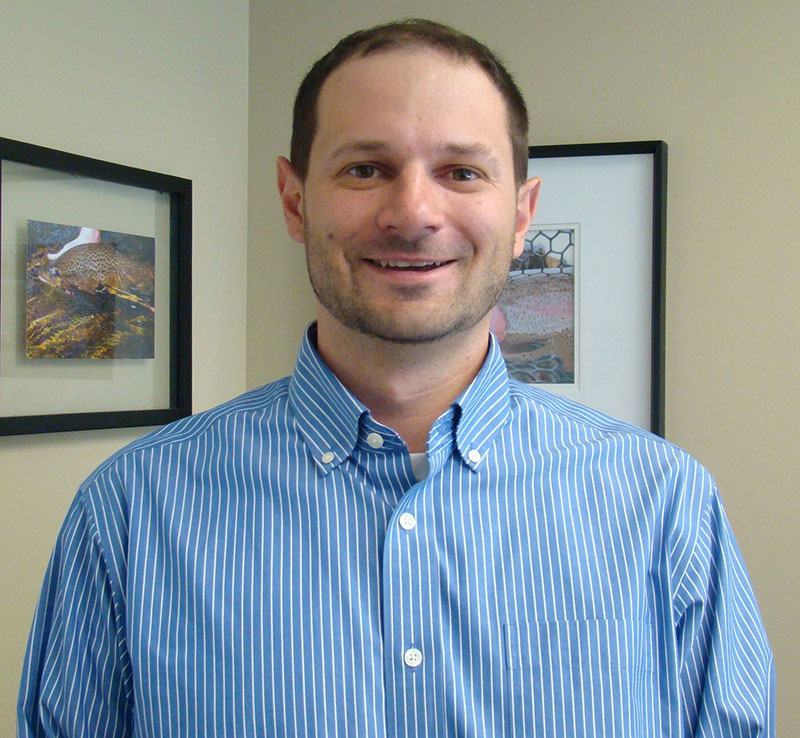A highly competitive grant from the Burroughs Wellcome Fund will lay the foundation for better treatments for invasive fungal infections.
Fungal spores are everywhere—in your garden, probably in your carpet, and even in the air. For most people this is not a problem. But for those with a weakened immune system, such as people undergoing chemotherapy or recipients of an organ transplant, exposure to certain fungi can be dangerous. One of the chief troublemakers, Aspergillus fumigatus, can be deadly when it invades the lungs or other organs. Robert Cramer, PhD, an assistant professor of microbiology and immunology at Dartmouth’s Geisel School of Medicine, wants to know why invasive A. fumigatus is so virulent.

“In general, fungi do not grow well at human body temperature,” explains Cramer. “Yet there is something about the biology of this organism that allows it to do very well in a human host who has a weakened immune system, and we just don’t know what that is.”
Cramer’s research interests in A. fumigatus and his proven track record—publishing important papers and securing major funding from the National Institutes of Health—earned him a prestigious $500,000 grant from the Burroughs Wellcome Fund (BWF). In 2014, BWF, an independent private foundation, made grants totaling $21 million to 48 biomedical scientists nationwide. Cramer is one of only 12 to receive the foundation’s Investigators in the Pathogenesis of Infectious Disease award this year. A grant from the Dartmouth SYNERGY program is also supporting Cramer’s work. Such grants, from private foundations and one’s own institution, are critical to exploring new lines of research that can lead to major breakthroughs.
Tough to treat
Fungal diseases are difficult to diagnose and most are not reported to health agencies, so it is unclear how many people are infected with fungi. Recent estimates suggest about 200,000 people worldwide are infected with A. fumigatus, according to Cramer. For those with an invasive infection, the chance of dying from the disease ranges from 25% to 90%, depending on a variety of factors. Fungal infections are particularly tough to treat because fungi and humans share many of the same genes.
“There are basically two classes of antifungal drugs that work,” says Cramer. “Both have significant toxic side effects, and drug resistance is an emerging problem.”
“Our goal is to understand how Aspergillus fumigatus generates the energy it needs to cause disease, even with all the stresses it encounters growing in someone’s lung,” says Cramer. If Cramer and his team can figure that out, scientists will have a better chance of developing an effective treatment for A. fumigatus and other fungi that are dangerous for humans.
Superior bioenergetics
One of the major barriers A. fumigatus faces when it grows in the lung is, surprisingly, a lack of oxygen. When the organism invades a lung, immune cells surround the fungus and compete for nearby oxygen. In addition, because the fungus damages the adjacent vasculature, even less oxygen is available. Yet the fungus continues to grow and cause damage.
Cramer thinks the key to containing the organism’s virulence lies in unraveling its superior bioenergetics—its ability to make the energy it needs to grow in harsh environments, when it is depleted of oxygen and surrounded by immune cells. The grant from the BWF will allow Cramer to explore a variety of approaches: biochemical, genetic, and a novel application of an existing clinical technology—a hyperbaric chamber. In preliminary studies, Cramer has found that saturating the fungus and infected tissue with oxygen in a hyperbaric chamber stops the fungus from growing.
“It’s unclear whether hyperbaric oxygen in and of itself will end up being a treatment for these infections,” says Cramer, who is collaborating closely with Dr. Jay Buckey, a professor of medicine at Geisel and a hyperbaric medicine specialist. But he is hopeful that the technology, as well as his lab’s biochemical and genetic investigations, will help identify the mechanisms by which A. fumigatus grows into a deadly infection. And that will bring scientists like Cramer one important step closer to creating an effective treatment for the hundreds of thousands of patients worldwide infected with this fungus.